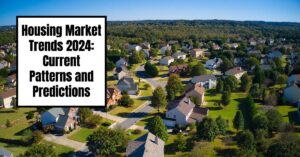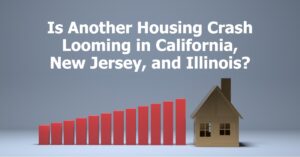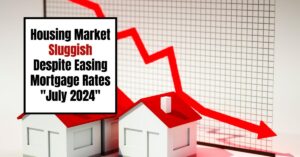As the housing market trends illustrate, the dynamics of buying and selling homes in the U.S. have become increasingly complex. With U.S. pending home sales hitting a record low in July, many wonder what this indicates about the future of the housing sector. This situation arises from various influences that are collectively reshaping the real estate environment, impacting both potential buyers and sellers across the country.
Housing Market Trends: Record Low Pending Sales in 2024
Key Takeaways
- Record Low Sales: Pending home sales dropped 5.5% in July, reaching a historic low of 70.2 on the Pending Home Sales Index (PHSI).
- Year-over-Year Decline: Compared to July 2023, pending transactions are down 8.5%, showcasing a tough year for potential buyers.
- Regional Struggles: All four U.S. regions experienced monthly losses, with the Northeast being the only region to show a year-over-year increase.
- Economic Factors: High borrowing costs, affordability issues, and ongoing economic uncertainties are impacting buyer confidence and market activity.
- Future Outlook: Experts predict a continued struggle in the housing market as consumers exhibit a wait-and-see attitude amid upcoming elections and economic pressures.
Analyzing the Record Low in Pending Home Sales
According to the National Association of Realtors (NAR), the Pending Home Sales Index (PHSI), a vital indicator based on contract signings, recorded a 5.5% decline for July. The index fell to 70.2, marking the lowest reading since it began in 2001.
This alarming downturn reflects the difficulties that buyers currently face, compounded by persistent affordability challenges and uncertainties surrounding future economic conditions.
Lawrence Yun, NAR's Chief Economist, remarked that despite job growth and higher inventory being favorable components, they were insufficient to mitigate affordability barriers and prospective buyers’ hesitance connected to the imminent U.S. presidential election (National Association of Realtors).
Regional Breakdown of Pending Sales
Let's delve deeper into the regional performance of pending sales, as it reveals critical insights into localized market conditions:
- Northeast Region: This area experienced a slight decline of 1.4% month-over-month, yet it showcased a 2.4% increase year-over-year, indicating some resilience amidst broader market struggles.
- Midwest Region: Reflecting more significant challenges, the Midwest saw a drop of 7.8% in July, which corresponds to an alarming 11.4% decrease compared to the previous year.
- Southern Region: The South faced a 6.5% decline, representing an 11.5% drop year-over-year—a clear sign that even traditionally strong markets are feeling the pressure.
- Western Region: The West recorded a 3.8% reduction in sales activity, down 6.0% from last July, indicating a consistent downturn that aligns with trends seen in the other regions.
These figures highlight that while specific regions may react differently to economic stimuli, the overarching theme is one of caution and declining buyer activity.
Economic Pressures and Buyer Sentiment
The persistent downturn in pending home sales reveals several underlying economic pressures affecting the housing market. For one, rising mortgage rates—which have recently stabilized yet remain high—have fostered an environment of uncertainty. Many potential homebuyers are now faced with crippling affordability constraints. The data indicates that many buyers are opting to withdraw from the market, leading to a substantial 8.5% decline in pending transactions compared to July of the previous year.
According to a recent Conference Board survey, consumer intent to purchase a home within the next six months is at its lowest level recorded since early 2013. This dip in consumer confidence suggests a deeper concern regarding personal financial stability and potential market volatility. Prospective buyers appear to be waiting for either a stabilization of home prices or a decrease in interest rates before committing to a purchase.
Adding to the complexity is the disparity in existing home prices and buyers' purchasing power. The Federal Housing Finance Agency (FHFA) recently reported a 5.1% year-over-year increase in home prices. This rise, while modest compared to previous years, signals that prices are not dropping in the face of declining sales. Rather, they are stabilizing at what many buyers find unobtainable.
Comparative Analysis of Consumer Sentiment and Housing Prices
The current housing market trends depict a paradox where strong demand meets overwhelmed supply. As prices remain high and inventory begins to increase slightly, many new buyers are feeling despondent. The struggle to attain an affordable mortgage coupled with the increased cost of living creates a disheartening environment for first-time homebuyers. Anecdotal evidence also suggests that many are opting to wait for a more favorable balance of prices and interest rates, reflecting a broader trend of postponed investments.
The Bigger Picture: Housing Market Trends Ahead
As we look to the future, the ongoing economic pressures and the upcoming political climate are expected to shape the housing market significantly. The sluggish nature of pending sales indicates that we may be entering a critical period for real estate, with many homeowners feeling trapped in their properties due to high mortgage rates and soaring prices.
Projected Developments in the Housing Market
Forecasts reveal a mixed forecast for the housing market. Some economists predict that as mortgage rates taper off, homebuyers may slowly return to the market, creating a rise in pending home sales. Reports from the Urban Institute suggest that if rates stabilize near 6%, we might see an uptick in sales activity, particularly in regions that have previously experienced substantial declines.
However, despite potential improvements, there remains a notable concern that house prices will continue to rise, albeit at a more controlled pace. Predominantly influenced by limited housing supply relative to demand, many experts believe that the Federal Reserve's monetary policies will significantly affect future market conditions. A reduction in interest rates could rejuvenate buyer interest, but any increases in economic volatility, such as inflation or changes in lending requirements, could stifle potential buyers’ enthusiasm.
Conclusion: The Path Forward for the Housing Market
The trends unfolding in the housing market reflect the complex interplay of economic factors and consumer sentiment that are defining the current landscape. As pending home sales reach a historic low, it becomes increasingly critical for stakeholders to remain adaptable and keenly aware of shifts in buyer behavior and economic conditions.
In summary, while the housing market trends currently reveal a challenging environment characterized by heightened caution and declining sales, the potential for recovery hinges on broader economic stability and consumer confidence. Monitoring these factors closely will prove essential as we navigate the complexities of the real estate market in the upcoming months.
ALSO READ:
- Housing Market Predictions for the Next 4 Years: 2024 to 2028
- Real Estate Forecast Next 5 Years: Top 5 Predictions for Future
- Is the Housing Market on the Brink in 2024: Crash or Boom?
- 2008 Forecaster Warns: Housing Market 2024 Needs This to Survive
- Housing Market Predictions for the Next 2 Years
- Real Estate Forecast Next 10 Years: Will Prices Skyrocket?
- Housing Market Predictions for Next 5 Years (2024-2028)
- Housing Market Predictions 2024: Will Real Estate Crash?
- Housing Market Predictions: 8 of Next 10 Years Poised for Gains
- Trump vs Harris: Which Candidate Holds the Key to the Housing Market (Prediction)











